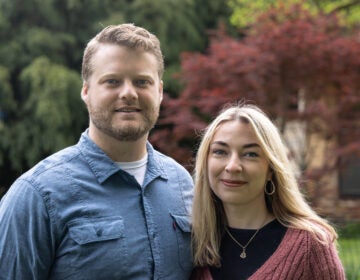NKCDC workshop represents convergence
June 2
By Matt Blanchard
For PlanPhilly
Right along with the boom in waterfront construction comes a boom in community planning, with at least five different plans popping up in recent months.
These glossy visions of an ideal Delaware don’t come from the city, but rather from grassroots groups and influential non-profits. Northern Liberties issued their waterfront plan in March, the anti-casino group NABR held a design-charrette last month, and PennPraxis is releasing design
guidelines for a seven-mile swath of the riverfront.
Rather than compete, these big and small plans seem to be feeding off each other, extending each other’s ideas, and mobilizing a core of designers and activists around the same design principles. With many of the same faces visible at public planning sessions, it often seems like the Delaware riverfront has grown its own unofficial planning commission.
On Saturday came the latest effort, “Draw Me a River,” a design workshop run by the New Kensington Community Development Corporation that engaged about 40 residents, architects and activists around maps and trace paper in a church hall near Lehigh Avenue.
Like the others, NKCDC was motivated by the condo boom (more than 3,300 units are either planned or in construction along the river), and by frustration that city government was doing little to ensure neighborhoods weren’t cut off from a privatized riverfront.
Since groups like Praxis are working on a comprehensive plan, NKCDC decided to narrowly focus yesterday’s charrette on designing “gateways” — streetscapes and landmarks that could link sites along the river back to the dense neighborhoods of Fishtown, East Kensington and Port Richmond.
Everyone who knows the riverfront knows the gateway problem well: On most blocks there’s no sense that a mighty river flows just yards away. Parks like Pulaski, Penn Treaty, and even Penn’s Landing are invisible behind the walls of I-95, and they frankly lack the amenities to draw people in.
Participants argued that to solve it, not only must the parks be expanded, but the major streets leading to them must become like parks, lined with trees and amenities to draw the waterfront vibe up into the neighborhoods.
“We in the neighborhoods shouldn’t wait forever to get what we deserve,” said architect David S. Traub, rallying support for his vision of an “Allegheny Avenue Greenway.” It would be a corridor of vegetation to soften the industrial tank farms and lead pedestrians down to Pulaski Park.
It’s the same sort of thinking visible in the other plans, and not by coincidence. Half the attendees at Saturday’s charrette are involved with one or more separate planning efforts.
“What’s great about it is that there’s planning happening on the large scale and there’s all this planning happening at the small scale, but with the same level of thought behind it,” said Nando Micale, an architect with Wallace, Roberts and Todd.
Handling design work for both NKCDC and PennPraxis, Micale himself is an important link in the waterfront planning web. He said he was impressed to see both energy and design-smarts from participants at Saturday’s charrette.
“In some cities, the general population is conversant on planning and design issues. Go to Portland or Seattle, or Boston,” he said. “I think that sort of knowledge is growing in Philadelphia.”
But is there any power behind all this planning? With 15 years in the planning game, Micale was optimistic: “Hopefully we’re at the point in Philadelphia where we can see this level of civic engagement translate into action … When you have the political will — and I think the next
administration will provide that leadership — all this planning will mean something.”
Even without a citywide architectural awakening, each neighborhood planning effort achieves a concrete goal: By setting down their principles now, neighborhoods like Fishtown can meet oncoming developers with a rock-solid sense of what they want.
For NKCDC, which covers a 200-block triangle from Frankford Avenue up to Lehigh Avenue, that might mean leveraging help from developers for projects like reusing the Lehigh Avenue railroad viaduct. The little-used structure today presents a three-story retaining wall to Lehigh Avenue, a chunk of which reportedly fell onto a city bus last week. It’s now owned by Conrail, but neighbors imagine wildlife areas and biking paths atop the structure — a rails-to-trails program that could lead west all the way to the Schuylkill River.
The end product of Saturday’s session, due to be published next month, will be something like a wish list.
“It will be a document we can give to developers and say, ‘This is what the residents of Fishtown, Port Richmond and Kensington have said they’d like to see built in their neighborhood,'” said NKCDC organizer Joe McNulty. “So if someone wants to build on the Conrail land, they can help fund the community vision for the Lehigh Viaduct.”
LINKS TO PLANS
When published, the new NKCDC plan and previous plans can be found here: http://www.nkcdc.org/
To see plans for a riverfront without casinos, see NABR’s new plan here:
http://www.nabrhood.org/
Two Northern Liberties Neighborhood Association plans (one for the
waterfront, one for the neighborhood) can be found here:
http://www.nlna.org/
Plans for a continuous riverfront trail can be viewed here:
http://www.drcc-phila.org/
WHYY is your source for fact-based, in-depth journalism and information. As a nonprofit organization, we rely on financial support from readers like you. Please give today.






